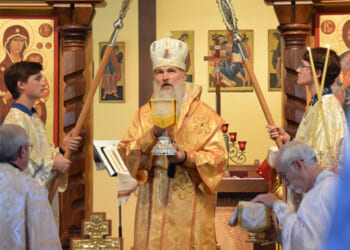Russia’s foreign military sales have plunged since the onset of the Ukraine War, as materiel destined for export has been rerouted to supply the Russian armed forces.
Throughout the Cold War, the Soviet Union went to great lengths to win gold medals in the Olympics, while also maintaining the world’s largest military force. However, Moscow consistently had to settle for “second place” when it came to arms exports, behind the United States. Following the dissolution of the Soviet Union in 1991, Russia continued to hold that spot—until 2022, when the Kremlin launched its unprovoked invasion of Ukraine.
Between 2020 and 2024, Russia’s arms exports decreased by 64 percent compared to the previous five-year period, according to data from the Stockholm International Peace Research Institute (SIPRI). Although Russia still holds the third spot on the proverbial podium, it has been overtaken in second place by France.
Moscow saw a 64 percent decline from 21 percent of the total global market from 2015 to just 7.8 percent last year. The decrease was primarily due to Russia’s massive losses in its ongoing “special military operation,” requiring the Kremlin to curtailed its exports and retool production to supply domestic military needs.
Moreover, Moscow has faced Western sanctions, which have limited its capabilities to maintain consistent production. Still, as with other developed nations, Russia continues to experience a severe labor shortage, exacerbated by a long-term demographic decline. That has also contributed to the nation’s high inflation, further impacting exports.
Russia Has Announced Its Aim to Reclaim Second Place
Officials at Rostec, the Russian state-owned military industrial conglomerate, now acknowledge that, as France and South Korea increase their military hardware exports, it will attempt to regain its position as the second-largest global supplier.
“This year, Rostec approved its new development strategy through 2036,” explained Rostec Executive Director Oleg Yevtushenko to state-media outlet TASS. “The difficult situation in the world and pressure from our main foreign competitors cannot change our strategic goal, which is to preserve second place in the global rankings of weapons-exporting countries until 2030 and through 2036.”
Regaining the second spot could be a fitting goal as Rosoboronexport, the sole state intermediary agency for Russian arms exports/imports, celebrated its 25th anniversary—the traditional “silver” anniversary—on Tuesday. The company is the legal successor of the state arms exporters that existed in the former Soviet Union and post-Soviet Russia.
Rostec CEO Sergey Chemezov had previously congratulated the company at the Seventeenth Spasskaya Tower International Military Tattoo in Red Square in August, which marked the 80th anniversary of the end of World War II.
The Rostec chief also predicted good times were to come for Rosoboronexport and the Russian arms industry.
“Over the past 25 years, Rosoboronexport has become one of the leaders of the global arms market, significantly expanding its order portfolio and volume of supplies,” Chemezov said in his opening remarks, adding that the company has signed more than 30,000 contracts since its founding, and exported military hardware valued at over $230 billion to some 120 countries around the world.
One Problem: Russia’s Main Clients Make Their Own Weapons Now
Where Russia’s exports may be increasingly complicated is with its two largest buyers, namely India and China. The countries remain regional rivals, but have been cautiously rebuilding relations following a period of tensions that began after the 2020 border clashes.
Beijing remains a buyer of Russian military hardware; yet, the nature of the trade has shifted as China has ramped up its domestic arms industry. China will continue to rely on key components, notably Russian jet engines, for its advanced fighters.
By contrast, even as India has increased its domestic production, it maintains close ties with Russia, including co-production deals. That could include a deal where the Sukhoi Su-57 (NATO reporting name “Felon”) fifth-generation stealth fighter is manufactured under license in India.
Beyond the military ties, it was also reported this week that Russia now expects to see a 30 percent increase in tourist exchanges with China compared to last year. Russian tourists may take in sights like the Great Wall of China and the Forbidden City, while Chinese sightseers could become more common in Red Square.
About the Author: Peter Suciu
Peter Suciu has contributed over 3,200 published pieces to more than four dozen magazines and websites over a 30-year career in journalism. He regularly writes about military hardware, firearms history, cybersecurity, politics, and international affairs. Peter is also a contributing writer for Forbes and Clearance Jobs. He is based in Michigan. You can follow him on Twitter: @PeterSuciu. You can email the author: [email protected].
Image: Shutterstock / ibWR111.


















